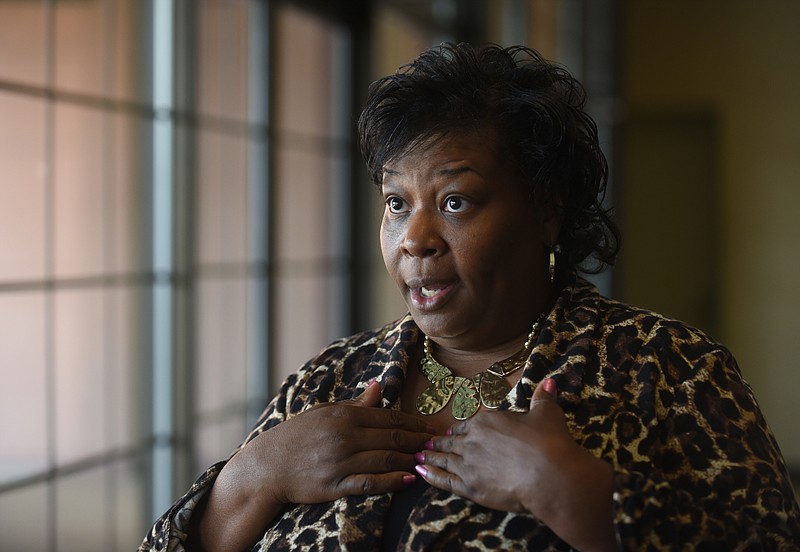Read more
Report about black Chattanoogans offers bleak picture, calls for unified action
In 1939, authorities with the federal agency known as the Homeowners Loan Corp. unrolled a map of downtown Chattanooga, then, using a scale of five different colors, graded each neighborhood as to whether it was worthy for real-estate investment or if it wasn't.
Some places - parts of North Chattanooga, the downtown side of Lookout Mountain, Brainerd - were considered low risk. Promising the best financial return, they were colored green and blue.
Other parts of the city were considered high risk, and marked in red and yellow.
Westside. Alton Park. Hill City. Clifton Hills. Much of east Chattanooga.
This process - called redlining - was a sort of financial indictment, a curse that spooked off investors, capital and imagination for years to follow.
Today, a sort of soft redlining still happens in Chattanooga. Neighborhoods remain forgotten, and the angels of reinvestment, capital and tax incentives seem to continually pass by. The sons of fathers and grandfathers remain mired in underemployment, violence and poverty.
As it was true in 1939, so it is true today: those neighborhoods are predominantly black.
"The roots of Chattanooga's segregated communities are deep," writes Dr. Ken Chilton, of Tennessee State University. "Redlining deprived these communities of reinvestment, creating concentrated enclaves of poverty and isolation."
And so begins the first pages of the new Chattanooga NAACP report: "The Unfinished Agenda: Segregation and Exclusion in Chattanooga and the Road Towards Inclusion." Released Monday, it sends the message:
Poor neighborhoods don't just happen. Black Chattanoogans aren't generationally poor just because.
"North Chattanooga, downtown and the Southside are all thriving while Alton Park, Westside and parts of East Chattanooga are surviving," the report states. "This is not by chance."
There has been no trickle down renaissance. Our revitalization has only been a half-truth, as for some, the last 20 years have meant more poverty, more segregation.
* The number of poor families - black and white - has increased since 1990.
* Thirty-five percent of black Chattanoogans are poor, compared to 14 percent of whites.
* Roughly 75 percent of Alton Park residents live on less than $25,000 per year.
* Our poorest neighborhoods are populated with black people.
* Our most failing schools are full of black children.
"The echoes of 'separate and unequal' reverberate," the report reads.
This is not to downplay the grandeur of our renaissance; rather, it is to say, acutely, that it has not delivered a significant part of our city into the promised land.
Once employed within living wage manufacturing jobs that could lead to a secure middle class life, black Chattanoogans now work in service-industry jobs - part of our tourist economy, which is part of our renaissance - and those jobs routinely pay less.
Our Gig has attracted workers in the talent and knowledge economy, but they are mostly white.
Go stand in the Southside. Within blocks of the fine dining, public art and hip bars? Dire black poverty. The zip code exists as a microcosm for the double face of Chattanooga: the Best City, and the worst.
"In Census Tract 20 - which includes Southside - the median household income for African Americans is about $50,000 less than that of whites," the report reads. "The socioeconomic difference, literally within blocks, is staggering."
Do we try to fix this with job creation? We have. Industries continue to arrive here, yet somehow, that model remains incomplete.
Better education? How bitter. Earlier this year, school leaders tried for a paltry tax increase; they were laughed out of town.
Something must shift in our approach and perspective, and that shift must include black Chattanooga leaders securing a role in naming their own problems, and determining their own solutions.
If deliberate policy choices - the report uses that phrase a lot - could create the beauty, bounty and big-hearted civicness of our downtown renaissance, then deliberate policy choices can also create the revitalization of this second Chattanooga.
But at what point does it happen?
At what point does the map of the face of Chattanooga change?
Or, at what point, as James Baldwin once wrote, does a dream deferred finally explode?
"We need fresh ideas, new voices and the type of innovative thinking that characterized Chattanooga's transformation from a dying industrial city to the vibrant community it is today," the report notes. "Only this time we need to be inclusive."
Contact David Cook at dcook@timesfreepress.com or 423-757-6329. Follow him on Facebook at DavidCookTFP.

